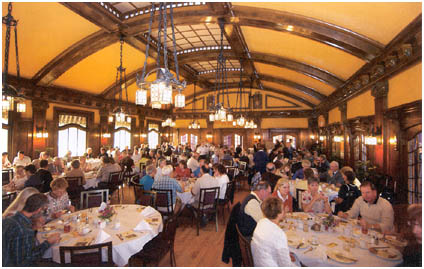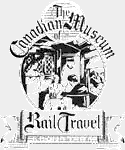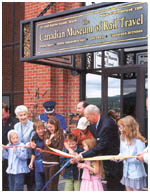|
Fall
2004

Canadian
Pacific Railway Employee Communications
Room 500 401-9th Ave S.W. Calgary AB T2P
4Z4
Railway Museum Highlights
Social History

Resurrected
Elegance: The cafe from CPR's Royal Alexandra Hotel, built in 1906 and
demolished in 1971, rises from the ashes of another era at the Canadian Museum of
Rail Travel in Cranbrook, B.C.
 When executive director
Garry Anderson championed the establishment of a premier railway museum in
Cranbrook, B.C., he wanted it to be more than just a tribute to luxurious passenger
cars - though with the restored equipment from CPR's first class name train
"The Trans-Canada Limited" (1929) and the
work-in-progress of "The Soo-Spokane De Luxe"
(1907) and "The Chinook" (1936) he certainly has those aplenty. More than
that, he said, "it should concentrate on historical social aspects; lifestyle,
elements of design, furnishings, decor, fashion, menus". When executive director
Garry Anderson championed the establishment of a premier railway museum in
Cranbrook, B.C., he wanted it to be more than just a tribute to luxurious passenger
cars - though with the restored equipment from CPR's first class name train
"The Trans-Canada Limited" (1929) and the
work-in-progress of "The Soo-Spokane De Luxe"
(1907) and "The Chinook" (1936) he certainly has those aplenty. More than
that, he said, "it should concentrate on historical social aspects; lifestyle,
elements of design, furnishings, decor, fashion, menus".
| |

Museum executive director, Garry
Anderson, often plays host to guests from the Royal Canadian
Pacific.
|
In 1976, with a degree in architecture from the University of British Columbia
under his belt and the museum organization in place, Garry set his mind to create a
one-of-a-kind showpiece that would do credit to the CPR and to
Cranbrook a location chosen not just for its sizable tourist business from the U.S.
and nearby Banff, Kootenay, Yoho, and Glacier National Parks, but for the historic
ties to the railway and the "other" route the CPR employed to reach the
West Coast, winding and twisting through the challenging terrain of southern
British Columbia.
"I think from the beginning, the museum has demonstrated its commitment to
excellence in preservation, restoration, and interpretation, and has always done
what it set out to do", Garry said. "Maintaining a historic collection of
this size and fragility is a long-term responsibility and one the
museum takes very seriously. "We believe it's been a winning situation for
both parties".
| |

B.C. Lieutenant Governor, The
honourable Iona Campagnolo, CPR's Paul Clark, and local children cut the
ribbon at the official opening.
|
Perhaps the biggest boost to the fortunes of the museum was Vancouver's Expo '86
and the invitation to exhibit the restored Trans-Canada Limited".
As their web site says, "that summer must have been like a
six-month appearance on the television show, "This is Your
Life". Sitting on the tracks at an important big city station, surrounded by
tourists and passengers; a taste of real passenger train activity".
But there were "loftier peaks to climb". In June of 1993, what was then
known as the Cranbrook Railway Museum took on the more ambitious name
"Canadian Museum of Rail Travel", with plans to move to a new building on
a larger site.
Garry drew upon his background in architecture; and when he discovered that an
entire room from the CPR's Royal Alexandra Hotel had been carefully dismantled,
piece by piece, and held in storage, he knew he not only had a millennium project
for the Town of Cranbrook, but also the unique and authentic interior to fulfill
his dreams for the museum.
Moving quickly to acquire a semi-trailer full of crates that had
languished for nearly 25 years in Winnipeg and then moved near Duncan, B.C., on
Vancouver Island, he would soon resurrect the elegant cafe from the railway's
popular Winnipeg hostelry - right down to the last piece of polished woodwork and
cast iron light fixtures.
With a grand new central entrance and lobby, coupled on one side to the magnificent
"Royal Alexandra Hall" and on the other to the town's original wooden
railway freight shed, built in 1898, all that was left was to move the museum's
fabulous collection of vintage railway cars. The CPR would be there to help.
On the Move With
CPR
The move of the museum's railcar collection to the new site in September 2002
couldn't have occurred without the direction and commitment of the local Cranbrook
CPR staff, particularly Dan Sewell (now manager of operations in the NMC), said the
museum's executive director Garry Anderson. "Dan realized the importance of
placing the cars in one secure place where they would be accessible to the general
public".
| |

From left: Bob Chauncey, Len
Tew, Dan Sewell, Ken Frocklage, Kevin Webster, Herman Kuhne, Don Steuart, Ted
Garner, Brian Gallia, Brian Babish.
|
For Dan's part, it was a labour of love. "It was easy to recognize Garry's
passion and commitment to the museum", he said. "He toured me through one
of the first pieces of rolling stock they had acquired, the solarium lounge car,
River Rouge. As fate would have it, my father, who was superintendent of the CPR's
Canyon Division 20 years before, had been instrumental in arranging the donation of
that car to the museum.
"The cars received full mechanical inspections and any necessary repairs were
done prior to the move. However, one car wasn't on its original frame, the luxurious
Palace sleeper "Omemee" from the Canadian Pacific's
Soo-Spokane International Line.
It gave us some concern; we called it the "Ohmygosh". But with the
skillful handling of our local employees, and the dedication of guys like Art
Stekman and Brian Gallia, we got it safely to its new location".
There's no doubt the move gave the CPR folks a greater sense of connection to the
museum. "They were wonderful to work with", Garry said. "Everyone
used great judgement and care".
This CP Rail News article is copyright 2005 by
Canadian Pacific Railway and is reprinted here with their permission. All
photographs, logos, and trademarks are the property of the Canadian
Pacific Railway Company.
|